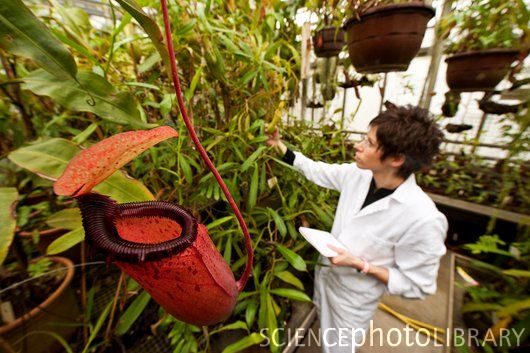
猪笼草(nepenthes)
美国物理学家组织网近日报道,哈佛大学应用科学家仿照猪笼草的疏水策略,开发出了一种极为光滑的涂层材料,几乎能排斥包括血液、油在内的任何液体,甚至在高压、冰冻等极端环境条件下,仍能保持排斥液体或固体的能力。这种仿生疏流技术在生物医学流体处理、燃料运输、防污、防冻等方面有着广泛应用,甚至有望带来一种能自动清洁的窗户和改良型光学设备。该研究发表在近期《自然》杂志上。
猪笼草是一种叶子像水杯的食虫植物,尤其在雨后,其叶子表面会变得几乎无摩擦,散发出甜味,吸引蚂蚁、蜘蛛、甚至小青蛙。猪笼草的疏水策略与其他植物完全不同,它能在顶部形成一件光滑的外衣,把液体本身变成了疏水面。受其启发,研究人员将一种润滑液注入具有纳米微结构的透气性材料中,制成了这种名为“SLIPS”的疏水表面,意为“灌注液体的光滑透气表面”。
“我们开发的新型涂层材料胜过天然和人工的同类产品,为固液间排斥问题提供了一种简单而多用途的解决方案。”论文首要作者、哈佛大学工程与应用科学院的乔安娜•艾森伯格解释说,目前的其他疏水面,如仿荷叶效应疏水,利用的是表面特殊纹理结构,使水滴聚集滑落,但荷叶效应对一些有机物或复杂液体无效,表面刮擦后或在极端条件下,液体反而会黏附或沉积在上面,而且这种疏水面难以制作,成本很高。
“SLIPS就像猪笼草那样,不仅能滑倒昆虫,还能排斥多种液体和固体,几乎毫无阻滞,极轻微的倾斜都会让液体或固体从它表面上滑下来。”艾森伯格说。他们用蚂蚁做了多次实验,发现蚂蚁会从上面滑落,或刚爬几步就赶紧退回地面。
论文首要作者、艾森伯格实验室博士后王德成(Tak-Sing Wong)说:“由于SLIPS非常光滑,即使用刀子刮坏一部分,也能立即自行修复,修复后仍保持疏流性能,这让它能作为一种自动愈合材料。如果制成光学透镜,也是一种理想的自动清洁设备。”
此外,它在高压(675个大气压,相当于海平面以下7000米)、潮湿、低温等极端条件下也能保持这种几乎无摩擦的特性。研究小组在一次暴风雪之后进行了实验,发现它在严寒中还能排斥冰。艾森伯格说:“SLIPS的稳定性和独特的自愈能力,让它几乎能胜任任何应用,如极地或深海探测,为严苛条件下的应用带来了广阔前景。”
“我们的仿生表面不仅能在各种环境下发挥作用,而且成本低、制造简单。”论文合著者、艾森伯格实验室博士生姜成勋(Sung Hoon Kang)说,“它还能改进升级,因为你可以选择任何种类的透气材料和多种润滑剂。”
目前,研究人员正在为这种仿猪笼草技术申请专利。他们预计,该技术将来可用于运输燃料和水的管道、医用导管(如导尿管和输血系统)、自动清洁窗、无菌无垢表面等,还可进一步开发出排斥冰的材料,以及不留指纹或乱画痕迹的抗粘表面等。
生物探索推荐英文论文摘要:
Bioinspired self-repairing slippery surfaces with pressure-stable omniphobicity
Creating a robust synthetic surface that repels various liquids would have broad technological implications for areas ranging from biomedical devices and fuel transport to architecture but has proved extremely challenging1. Inspirations from natural nonwetting structures, particularly the leaves of the lotus, have led to the development of liquid-repellent microtextured surfaces that rely on the formation of a stable air–liquid interface. Despite over a decade of intense research, these surfaces are, however, still plagued with problems that restrict their practical applications: limited oleophobicity with high contact angle hysteresis, failure under pressure and upon physical damage, inability to self-heal and high production cost. To address these challenges, here we report a strategy to create self-healing, slippery liquid-infused porous surface(s) (SLIPS) with exceptional liquid- and ice-repellency, pressure stability and enhanced optical transparency. Our approach—inspired by Nepenthes pitcher plants—is conceptually different from the lotus effect, because we use nano/microstructured substrates to lock in place the infused lubricating fluid. We define the requirements for which the lubricant forms a stable, defect-free and inert ‘slippery’ interface. This surface outperforms its natural counterparts and state-of-the-art synthetic liquid-repellent surfaces in its capability to repel various simple and complex liquids (water, hydrocarbons, crude oil and blood), maintain low contact angle hysteresis (<2.5°), quickly restore liquid-repellency after physical damage (within 0.1–1 s), resist ice adhesion, and function at high pressures (up to about 680 atm). We show that these properties are insensitive to the precise geometry of the underlying substrate, making our approach applicable to various inexpensive, low-surface-energy structured materials (such as porous Teflon membrane). We envision that these slippery surfaces will be useful in fluid handling and transportation, optical sensing, medicine, and as self-cleaning and anti-fouling materials operating in extreme environments.







